The Massive #1 ($3.50, Dark Horse)
by D.S. Randlett (@dsrandlett)
When this series was first previewed in Dark Horse Presents, with a couple of prelude stories that gave a glimpse into the prior lives of two of the series principal characters, I was struck by the melancholic power of the voice that Brian Wood found in those stories. In one story, there were very big events happening, and in the other nothing happened at all, but they both dwelled in that same space as those happy memories which are also your worst memories, touching on the instances in which we define ourselves. The first proper issue of The Massive is a bit more straightforward than that, but there are moments where it touches on similar emotional depths.
It’s a book of exposition, mainly. On the one hand, we’re seeing the story that’s happening “in the present.” A band of environmentalists are ekeing out an existence after a large scale climate collapse on a boat called “Kapital” (as in Marx’s, I assume) while looking for their lost, much bigger, sister ship called “The Massive,” hence the title. There are also pirates in Zodiac rafts that show up to attack the Kapital, and this supplies the some of the book’s rather unique action beats. There’s also the “what happened before” story, which holds the bulk of the book’s exposition. We’re treated to Tsunamis, earthquakes, flooded port cities and, rather touchingly gigantic pods of dead whales floating in the ocean. It’s a scene which recalls, and darkly inverts, a beautiful scene from a book to which The Massive owes a great debt: Moby Dick.
Melville’s fingerprints are all over the place here. Callum Israel (Call Me Ishmael), the leader of the group, is a calmer sort of Ahab, but he is still tinged with a similar sense of mourning and regret. What is interesting is that what he mourns is a world in which he was an antagonist. He was (is?) an environmentalist, and Mother Nature has won, even though she has sacrificed many of her children to do so. There’s a rather telling flashback where Israel and his crew are planning what to do to in the face of the disasters that are stretching across the globe, and a large, flat screen television is in the background, always appearing in the center of the panel. As much as these environmentalists acted against the old world, they are still of it. If you’ve built an identity out of rebellion, then who are you when the world that you’re rebelling against is gone? This is the question at the heart of the book.
Brian Wood’s writing is as it usually is here: fiercely intelligent. I don’t know how plausible any of the events here are, but they feel tragic and believable. For all of the callbacks to Moby Dick, Wood has opted to eschew Melville’s lyricism. The Massive feels as cold as it Siberian setting. Kristian Donaldson’s art reflects this. The style is very realistic, but also very stark and angular, Everything happens very matter of factly, and even the action is drawn with a sense of reserved distance. This has far from a distancing effect, however. Rather, it gives the story a feeling of bigness, calling to mind the lingering shots of David Lean or Akira Kurosawa.
The Massive is one of the must read creator-owned titles of the year. Wood’s talent for exploring current events through plausible scifi hasn’t let up. It may take you a couple of readings before you find your way in, but The Massive rewards the effort.
Rating: 




Out of a Possible 5 Stars
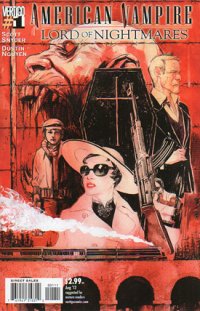 American Vampire: Lord of Nightmares #1 (Vertigo, $2.99)
American Vampire: Lord of Nightmares #1 (Vertigo, $2.99)
By Adam Prosser
While zombies are easily the most overplayed horror-movie monster in pop culture at the moment, vampires are running a close second. And yet, somehow vampires seem to maintain a sense of storytelling possibility that zombies don’t. I think there are a number of reasons for this; one is that a zombie narrative is fundamentally limited, being essentially a story about either survival or social upheaval, or both. Another is that vampires are intelligent, “magical” creatures with a shifting set of attributes and rules, allowing for every vampire in pop culture to be slightly different, and allowing a writer to insert them into almost any genre, or turn them into a metaphor for almost anything.
So vampires retain a certain freshness, so to speak, that zombies don’t. Or at least, they can. But of course they can easily risk becoming clichéd and tired, as well. I’ll admit I’m not fully caught up on Scott Snyder’s American Vampire, but the first few arcs were great, avoiding the pitfalls of the vampire genre by using vampires mostly as an excuse to tell an epic, centuries-spanning story of America as it passed through various eras. I’d call it a generational saga, like The Godfather movies, except with its key characters being immortal undead creatures there’s no real call for multiple generations. Nevertheless, it certainly has established itself as a unique story, which may be why Snyder feels justified in introducing more familiar elements into the mix with this tie-in miniseries.
How familiar? Would you believe…Dracula?
Just like vampires in general, the original pop culture vampire seems to be going through a bit of a renaissance lately, popping up in, for example, Blade 3 and elsewhere. Unlike vampires in general, however, it’s perhaps a bit more difficult to do anything new and interesting with Drac himself.
It doesn’t help that this story begins with another comic book saw, the Impenetrable Fortress built by a Secret Organization beneath a Familiar Landmark to contain an Ancient Evil. As these prisons always are, this one is breached in 1954, setting free Dracula and necessitating the recruitment of the half-vampire former agent Felicia Book to help bring him in. (Yes, I said half-vampire. Clearly, I’ve missed a few things in this series, because I have no idea how that happened…)
As clichéd as all this is so far, Snyder still makes it work via a sharp execution. There’s a fun tension-racked meeting at the beginning between British agents (their organization is called Vassals of the Morning Star) and a goofball American tourist who turns out to be a “Renfield”, and the tables are turned effectively. Snyder’s explanation for how Dracula gets free at this particular point in history is well thought-out. And his ear for dialogue is definitely sharp (well, except perhaps for the overdramatic final page). Over in the main book, Rafael Albuquerque has quietly become one of the most interesting and expressive comic book artists around, but for this miniseries, Dustin Nguyen does an admirable job of keeping up, both in terms of style and skill—I particularly like how he’s able to turn Mr. Glass from ludicrous to sinister without having his expression or demeanour change at all.
Still, I think it’s wise of Snyder to make this book a spinoff from the main series and not part of the main storyline. Dracula stands for the old world, for the dead hand of the past; it may be fundamentally impossible to make him seem new, and by doing so, he becomes a bit of a drag on any attempt to innovate. You can make him scary, but you can’t really make him feel vital.
Rating: 




Out of a Possible 5 Stars
Spider-Men #1 (Marvel, $3.99)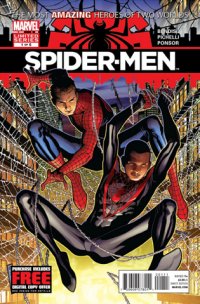
By Jeb D.
It’s not as revolutionary or transgressive as the idea of more Watchmen, but there’s no question that it’s been more or less taken for granted that the Ultimate Marvel universe was not simply an “alternative” to the regular Marvel U (or “616” if you’re a hipster pedant), but something conceptually removed from it, and that the two would never meet (remember the furor when Mark Millar teased what looked like a crossover between the two, only to have it turn out to be the opening salvo in the Marvel Zombies phenomenon?). That’s a legacy of the original Jemas/Quesada plan, in which the Ultimate consumer was buying their comics at Target or Toys R Us, while the comics nerd at his LCS would remain blissfully ignorant that out there somewhere was a version of Spider-Man with a living (and, thankfully, childless) Gwen Stacy. Given that things never panned out that way, that the Ultimate U’s buyers wound up being the same readers buying the regular Marvel titles, I’m not sure why it’s taken this long for that particular shibboleth to fall. And unlike the fragmentary nature of Beyond Watchmen, there’s really not a lot of freedom for wiggle or improvisation: you put the Spider-Men of two universes in one book, and, well, they pretty much have to meet up. And while that rather circumscribes what can be done with a five-issue miniseries, within those confines, Spider-Men is off to an excellent start.
It’s nice to see writer Brian Bendis cutting loose with the regular Marvel U version of Spider-Man: good company man that he is, Bendis has done his darndest to accommodate the awkwardness of Spidey’s Avengers membership, but he never seems particularly comfortable with the idea, with the character often feeling shoehorned into storylines that don’t really need him or his quippiness. With this full issue devoted to his uncovering the events that will set the crossover in motion, Spidey has room to breathe, with an engaging interior monologue, a few good wisecracks, a bit of action, and some great comic musings. If Dan Slott has perfected the voice of the modern Peter Parker, Bendis reminds us here that he’s not far behind in his understanding of the character’s fundamental strengths. And, yes, I did say a “full issue”: not to get spoilery here, but just to avoid potential letdown, the actual meeting of the two Spider-Men is a last-page moment; whether it’s immediately picked up next issue (or whether we spend issue #2 repeating the process with Miles Morales), I have no idea. But getting to that point was certainly highly entertaining.
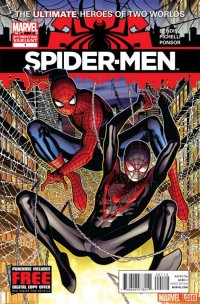 At this point, it’s hard to think of how to heap more praise on artist Sarah Pichelli’s contributions to the Ultimate Version of Spider-Man, so it’s nice to be able to marvel (so to speak) at her ability to shade the worlds of Peter Parker and Miles Morales so distinctly from each other. The widescreen “cartooniness” of the Ultimate Universe has never seemed such an effective artistic choice as it is here, when we view the contrast between the two universes through Peter’s eyes; she and letterer Cory Petit even carefully give each universe its own distinctive style of narration boxes and word balloons.
At this point, it’s hard to think of how to heap more praise on artist Sarah Pichelli’s contributions to the Ultimate Version of Spider-Man, so it’s nice to be able to marvel (so to speak) at her ability to shade the worlds of Peter Parker and Miles Morales so distinctly from each other. The widescreen “cartooniness” of the Ultimate Universe has never seemed such an effective artistic choice as it is here, when we view the contrast between the two universes through Peter’s eyes; she and letterer Cory Petit even carefully give each universe its own distinctive style of narration boxes and word balloons.
You will note that I’ve put up both the regular cover and “alternate” versions of the cover with this review, because someone at Marvel needs to be shamed into admitting it was their idea to take Pichelli’s perfectly serviceable original cover, with the two masked Spider-Men, and replace it with one where their faces are badly photoshopped over it (and, worse, to make that the “official” cover!). I understand that Toby Maguire or Andrew Garfield may have it in their contracts that they have to spend X amount of time onscreen without their masks, but Peter Parker and Miles Morales don’t get to make those sorts of demands. Christ, that thing is fugly.
Rating: 




Out of a Possible 5 Stars
Before Watchmen: Silk Spectre #1 ($3.99, DC)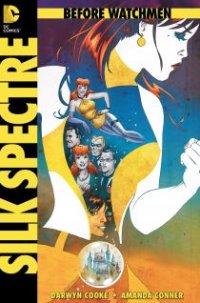
by D.S. Randlett (@dsrandlett)
Before Watchmen is receiving a lot of ire. It’s an understandable thing, and I fit somewhere in the middle of it all, wishing this project didn’t exist, while at the same time hoping for the best. Last week, Adam voiced some concerns surrounding DC’s treatment of Alan Moore, and the big two’s treatment of those to whom they owe substantial creative debts. I share those concerns, and putting my money behind projects like Before Watchmen or the Avengers movie don’t exactly make me feel dirty or that I should be boycotting, there is a bit of regret there, not to mention incentive to donate to Hero Initiative.
But assume that that wasn’t a concern. Assume that the original Watchmen existed as a revolutionary work for hire gig, much like Moore’s run on Swamp Thing, and that DC had not pursued further Watchmen series or stories solely out of respect for the achievement of Alan Moore and Dave Gibbons. What are we left with then? Even without the ethical considerations, and despite the mustering of some pretty considerable talent behind the effort, Before Watchmen would still be creatively compromised.
Darwyn Cooke and Amanda Conner are obviously very talented people, and they are trying very hard to honor the voice and feeling of the original Watchmen. Their efforts are futile, thanks largely to the prequel conceit of the series. The problem is not that we know what is going to happen, but that pretty much every emotional beat that could be explored in this series has already been explored concisely and to great effect already. The best that this issue achieves is plaintive echoes of the primary source.
While Cooke and Conner try to capture some of Moore and Gibbons voice, they ultimately fail. It feels much like the Watchmen film: it is an aping rather than a tribute. Silk Spectre gets some of the motions down, but the content behind them feels off. Like the image the nom-de-crimefighting of the principal heroine evokes, Silk Spectre, and the Before Watchmen effort, is but a shade.
Rating: 




Out of a Possible 5 Stars
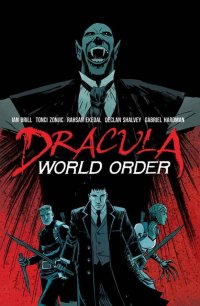 Dracula World Order: The Beginning ($3.99 from Draculaworldorder.com)
Dracula World Order: The Beginning ($3.99 from Draculaworldorder.com)
By Jeb D.
Love of comic books can be a dangerous thing.
When a writer has a story to tell, the choice of medium is always an important one; objectively, you want to match the medium to the story you’ve got in mind. But comics are enormously seductive for anyone who grew up with them, fondly remembering the medium as they knew it from childhood, regardless of whether that’s really where their story belongs. And even if writer Ian Brill isn’t old enough to remember the spinner rack of 12- or 25-cent comics at the local drugstore, he certainly developed his relationship as a consumer with the medium in a very different landscape than the one he faces today as a creator. Introducing a new comics series is no longer simply a matter of getting the habitual reader to add another inexpensive pamphlet to the week’s stack; in fact, it requires a considered purchase, one that likely involves the buyer’s decision to pass on the latest chapter in an ongoing spandex saga or zombie jamboree; and, of course, the full-length “graphic novel” is a lengthy and expensive undertaking, in which writer and artist(s) are usually working, essentially, for free until the thing finally hits the stands and some cash flow is generated. So when a writer wants to tell their story in comics form, in a way that will be competitive in today’s shrinking marketplace, he’s often compelled to go the serial/miniseries route, dispensing with the kind of carefully textured worldbuilding that marks great fantasy/SF/speculative/horror storytelling, and jump in with both feet: hit the new reader with everything you’ve got, rather than taking a chance on anything remotely subtle being overlooked.
I’m guessing you can see where this is headed: Dracula World Order: The Beginning has some neat ideas for breaking yet another Dracula tale out of the “not again!!” rut, and I could easily imagine all the storylines touched on in this issue being given full and interesting treatment in a novel. After all, the reader who has paid for a self-contained book is more likely to hang in for a few chapters while the author carefully constructs his environment, introduces his characters, sketches his conflicts, etc. But Brill doesn’t seem to feel he can take that chance, given that he needs to persuade a reader to come back and buy again and again; as a result, what should have been “shown” to us in the form of an unfolding plot is instead “told” to us by means of one character pretty much explaining everything to another. And that’s a shame: while the world that Brill has created is an intriguing one, there’s a strong sense that many of its most interesting secrets have already been exposed; really, the book is awkwardly named, as the “beginning” of this world order has already happened.
Set in a sort of alternate 2012, our protagonist is Alexandru, the son of Dracula. His father has come into ultimate power and shaped a “new world order,” with his vampiric minions standing in for “the 1%,” and Alexandru attempting to rally the other 99% to wipe out the plague, motivated as much by shame at his lineage as any actual empathy with humankind. During the course of this issue, he begins to assemble a team to accomplish that, beginning with Vincent Macready, last of the “vampire hunters,” who he rescues from a particularly nasty form of sanguinary surgery, finding him a convenient blank-slate of a Watson to whom everything needs to be explained in detail. As the two reluctant allies move through the pages of the story, more fantastic fighters, and visually imaginative baddies, are added to the mix, each story begun and ended in a few quick pages. Given the necessities of having chosen that approach, Brill tells his story with reasonable efficiency; the dialogue is flat and functional, but he really hasn’t left himself room for much more than that, anyway. And, again, every storyline here (particularly Dracula’s rise to power) would have so much more effectiveness, and set the stage more appropriately, if it had had time to grow and develop, rather than being a bit of exposition just to catch us up. I’d also suggest that ending the story on a bit of a cliffhanger, then indicating in the backmatter that it may, or may not, be followed up any time soon, just underlines the problem: fairly or not, one is left asking “All those stories to tell, and he can’t even finish this one?”
Brill has managed to assemble a terrific team of artists, including Tonci Zonjic, Rahsan Ekedal, Declan Shalvey and Gabriel Hardman (with colors from Jorie Bellaire and Stephen Downer), and between them they do a fine job of supplying the pulpy and/or fantastic grace notes that Brill doesn’t have time to script.
I wish I could give this particular issue a stronger recommendation, because as I say, there’s some great concepts at its foundation; too, Brill’s more likely to have the chance to build on those concepts if this first book sells, and I’m strongly in favor of championing those who self-publish. But if I’m being honest, I’d suggest waiting: if he does develop the story in further volumes, this will serve as a pretty good introduction; if it remains a standalone, though, I couldn’t really call it a complete success.
Rating: 




Out of a Possible 5 Stars